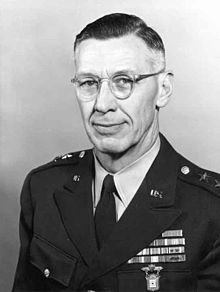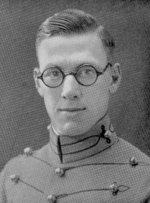| This article includes a list of general references, but it lacks sufficient corresponding inline citations. Please help to improve this article by introducing more precise citations. (January 2019) (Learn how and when to remove this message) |
| Holger Toftoy | |
|---|---|
 | |
| Born | Holger Nelson Toftoy (1902-10-31)31 October 1902 Marseilles, Illinois, U.S. |
| Died | 19 April 1967(1967-04-19) (aged 64) Huntsville, Alabama, U.S. |
| Resting place | Arlington National Cemetery |
| Alma mater | United States Military Academy |
| Occupation | Military officer |
| Military career | |
| Allegiance | |
| Service | |
| Years of service | 1922–1960 |
| Rank | Major general |
| Battles / wars | World War II |
Major General Holger Nelson Toftoy (31 October 1902 – 19 April 1967) was a United States Army career officer instrumental to the development of the United States' early rocketry after World War II, such as the Redstone missile. He persuaded senior officers to bring German scientists to the US after the war, to make use of their expertise, and supervised the relocation of more than 119 scientists.
In 1952 he was appointed to direct the Ordnance Missile Laboratories at Redstone Arsenal near Huntsville, Alabama. By 1958 he was deputy commanding general of the Army Ordnance Missile Command, Redstone Arsenal. Later that year he was reassigned as commanding general of Aberdeen Proving Ground, Maryland. Two years later he retired because of health issues, and moved to Florida.
Early life and military career

Toftoy was born on 31 October 1902, in Marseilles, Illinois. He attended local schools before college.
He studied at the University of Wisconsin–Madison as an ROTC cadet before transferring to the United States Military Academy at West Point, where he graduated in 1926. After taking basic flight training, he was transferred to the Coast Artillery and served three years in Hawaii as a battery commander before returning to West Point as an instructor.
In the 1930s Toftoy was assigned to the Panama Canal to command the mine defenses of the Pacific approaches. In 1938 he was transferred to the Submarine Mine Depot in Fort Monroe, where he served six years as chief of the Industrial and the Research and Development divisions.
Operation Paperclip
While working at the Submarine Mine Depot, Toftoy oversaw the development and design of a new system of controlled submarine mines that was widely using during World War II. Toftoy acquired great expertise in mines and explosives; he helped clear harbors in France during the war.
In 1944, Toftoy became chief of the Army Ordnance Technical Intelligence teams assigned to Europe to seek and evaluate captured enemy ordnance weapons and equipment. During this time, Toftoy received a request from Colonel Gervais Trichel, chief of the rocket branch in the Ordnance Department at the Pentagon, to acquire and ship 100 operational V-2 rockets to the White Sands Missile Range in New Mexico for testing. Soon after the Allied capture of the areas around Nordhausen and the Mittelwerk, Toftoy set up Special Mission V-2 to do the job.
He assigned Major William Bromley in command of the special mission, who reported to Toftoy through Major James P. Hamill. The latter was responsible for shipping the weapons from Nordhausen to Antwerp, and from there to New Orleans, for transportation to White Sands. Bromley and Hamill went to central Germany to salvage as many missiles as they could, under pressure because of the unwelcome news that U.S. forces would soon be withdrawing, as Nordhausen was in the planned Soviet Zone of Occupation, later East Germany. Although one hundred complete V-2s were not available, Toftoy organized U.S. soldiers and camp workers to put partially completed rockets and major components into hastily requisitioned rail cars. From 22 to 31 May, several freight trains left Nordhausen for Antwerp loaded with missile and missile parts, thus successfully completing the mission.
Toftoy knew the U.S. Army was planning to add guided missiles to its weapons program. He cabled the Pentagon, then personally went to Washington to recommend to senior officers that German scientists be brought to the U.S. for interrogation and possible employment. The mission became known as Operation Paperclip. By September 1945, the first group of scientists, including Wernher von Braun, had arrived in the United States. In the first year of this program, some 119 German scientists were brought to the United States under Toftoy's leadership. Toftoy was transferred to Washington and assigned responsibility for direction of the Army guided missile program.
After the war

In 1952, Toftoy was assigned to Redstone Arsenal, Alabama, as director of the Ordnance Missile Laboratories. This was responsible for planning, technical control, and supervision of what had become the nationwide Army guided missile and rocket development program. During this time the arsenal became responsible for the research, development, procurement, production, storage and maintenance of the entire Army family of missiles and rockets; some of the products of that program became widely used in the U.S. Military program. They included the PGM-19 Jupiter, the MGR-1 Honest John, the LIM-49 Nike Zeus and the MIM-3 Nike Ajax, among others. In 1958, Toftoy became deputy commanding general of the Army Ordnance Missile Command, Redstone Arsenal. He served as commander at RSA until July 1958, when he was named the commanding general of Aberdeen Proving Ground, Maryland (August 1958).
In 1960 Toftoy retired from the army for health reasons, and moved to Treasure Island, Florida. There he had a private boat landing and access to the Gulf of Mexico for indulging in his passion for fishing. He continued to be active in his field, retained as a consultant by the Northrop Corporation and by the Brown Engineering Company. He also became involved in local civic affairs; he was elected in 1962 as President of the Isle of Capri Civic Association.
Death and honors
After recurrence of an old ailment during a Christmas visit to his daughter at Huntsville in 1966, Toftoy was transported to Walter Reed Army Medical Center. He underwent four major operations in the following months. Toftoy died on 19 April 1967. Burial was in Arlington National Cemetery with full military honors.
- Toftoy Hall was dedicated at Redstone Arsenal on November 3, 1967; it provides basic electronics training for soldiers. It now houses the Education Center.
- The Ordnance School at Fort Lee has a Toftoy Hall for the Armament and Electronic Maintenance Training Department.
- In 1968, a commemorative plaque was placed in Big Spring Park in Huntsville, Alabama. Townspeople had nicknamed him as "Mr. Missile". He was a member of Helion Lodge #1 Free & Accepted Masons in Huntsville.
Dates of rank
| Insignia | Rank | Component | Date |
|---|---|---|---|
| No insignia | Cadet | United States Military Academy | 1 July 1922 |
| Second lieutenant | U.S. Army Air Service | 12 June 1926 (transferred to United States Army Coast Artillery Corps 9 March 1927) | |
| First lieutenant | Regular Army | 25 November 1931 | |
| Captain | Regular Army | 12 June 1936 | |
| Major | Army of the United States | 31 January 1941 (accepted 5 February 1941) | |
| Lieutenant colonel | Army of the United States | 1 February 1942 | |
| Colonel | Army of the United States | 17 March 1943 | |
| Major | Regular Army | 12 June 1943 | |
| Colonel | Regular Army | 15 May 1950 | |
| Brigadier general | Army of the United States | 1 November 1952 (backdated to 1 January 1952) | |
| Major general | Army of the United States | 1 January 1952 | |
| Brigadier general | Regular Army | 31 March 1955 (backdated) | |
| Major general | Regular Army | 31 March 1955 |
See also
References
- Piszkiewicz, Dennis (2006). The Nazi Rocketeers: Dreams of Space and Crimes of War. Stackpole Books. pp. 216–218.
- Neufeld, Michael (2008). Von Braun: Dreamer of Space, Engineer of War. Vintage Books. pp. 208–210.
- Laney, Monique (2015). German Rocketeers in the Heart of Dixie: Making Sense of the Nazi Past During the Civil Rights Era. New Haven and London: Yale University Press. p. 26. ISBN 978-0-300-19803-4.
- "U.S. Army Aviation and Missile Command".
- ^ Official Army and Air Force Register (Volume II: R-end). Washington, D.C.: U.S. Government Printing Office. 1948.
- ^ Official Army Register, Volume I. Washington, D.C.: U.S. Government Printing Office. 1955.
- ^ Official Army Register, Volume I. Washington, D.C.: U.S. Government Printing Office. 1957.
- ^ Official Army Register, Volume I. Washington, D.C.: U.S. Government Printing Office. 1960.
- 1902 births
- 1967 deaths
- United States Army personnel of World War II
- United States Military Academy faculty
- People from Marseilles, Illinois
- United States Military Academy alumni
- University of Wisconsin–Madison alumni
- Burials at Arlington National Cemetery
- United States Army generals
- Operation Paperclip
- People from Treasure Island, Florida
- Military personnel from Illinois